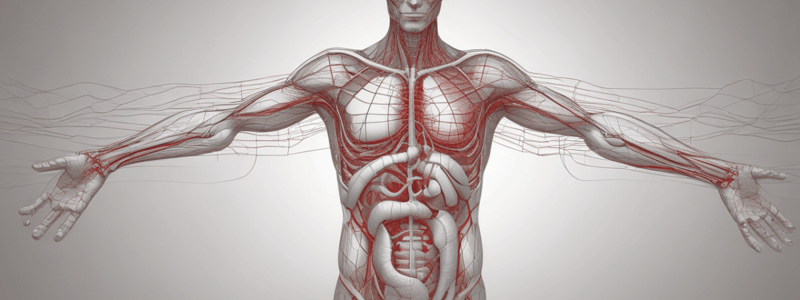Podcast
Questions and Answers
What is the location where you can feel your pulse by placing two fingers?
What is the location where you can feel your pulse by placing two fingers?
- On the inside of your wrist under your thumb (correct)
- Behind your ear
- On the outside of your ankle
- On top of your shoulder
What happens to the blood inside the heart during a heartbeat?
What happens to the blood inside the heart during a heartbeat?
- It flows back into your veins
- It gets stored for later use
- It is pushed out quickly into your arteries (correct)
- It stays still and does not move
Why do you feel a thumping when you take your pulse?
Why do you feel a thumping when you take your pulse?
- Because your heart is beating too fast
- Because your arteries are too elastic
- Because the force of the blood rushing through the arteries causes the elastic walls to stretch (correct)
- Because your muscles are too strong
What is the normal range of heartbeats per minute when someone is at rest?
What is the normal range of heartbeats per minute when someone is at rest?
What is the purpose of taking your pulse?
What is the purpose of taking your pulse?
What would happen if you used all of your muscle to squeeze a tube of toothpaste?
What would happen if you used all of your muscle to squeeze a tube of toothpaste?
What is the heart similar to when it beats?
What is the heart similar to when it beats?
What happens to the heart before every beat?
What happens to the heart before every beat?
What is the movement of the arteries called when your heart beats?
What is the movement of the arteries called when your heart beats?
How often do you feel a thump when you take your pulse?
How often do you feel a thump when you take your pulse?
Flashcards are hidden until you start studying
Study Notes
Taking Your Pulse
- To take your pulse, place your left hand out in front of you and press the first two fingers of your right hand on the inside of your wrist, just under your thumb.
- You should feel a "thump, thump, thumping" sensation under your fingers, which is your pulse.
What is Pulse?
- Your pulse is the movement of your arteries as your blood rushes through them.
- You can feel your pulse by pressing down anywhere a large artery is near your skin, such as on your wrist, neck, or behind your knee.
- Each thump you feel is actually one heartbeat.
How the Heart Works
- The heart is a muscle that contracts to move blood around your body.
- Before every beat, the heart fills with blood, and then it beats.
- During the beat, the sides of the heart squeeze together, pushing blood out quickly into your arteries.
- The push from the heart causes the thumping of your pulse.
Arteries
- The walls of the arteries are thin and elastic, like a rubber band.
- The force of the blood rushing through the arteries causes the elastic walls to stretch, which you can feel when you take your pulse.
Heart Rate
- Your pulse can tell you a lot about how hard your heart is working.
- When you're at rest, your heart beats between 60 and 100 times a minute.
- You can figure out your heart rate by measuring your pulse and counting how many thumps you feel in one minute.
- If you're exercising, your heart has to beat faster to keep up, and it can beat up to 200 times in one minute.
Studying That Suits You
Use AI to generate personalized quizzes and flashcards to suit your learning preferences.




